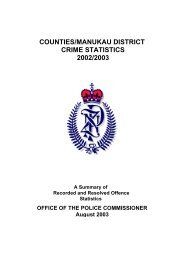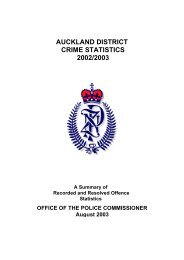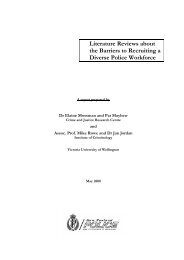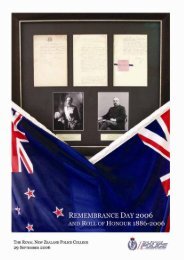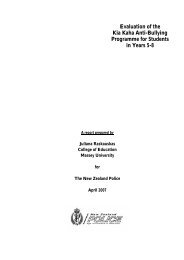Police Perceptions of Maori - Rethinking Crime and Punishment
Police Perceptions of Maori - Rethinking Crime and Punishment
Police Perceptions of Maori - Rethinking Crime and Punishment
You also want an ePaper? Increase the reach of your titles
YUMPU automatically turns print PDFs into web optimized ePapers that Google loves.
General questions on policy <strong>and</strong> strategy<br />
With respect to police policy <strong>and</strong> strategy, a number <strong>of</strong> items based on the draft policy<br />
(Policing 2000 Strategy Group, 1997) were developed <strong>and</strong> respondents were asked to<br />
rate each <strong>of</strong> these on a five point scale from 'strongly agree' to 'strongly disagree'.<br />
Background characteristics<br />
Finally, items were devised to determine the respondents current duties in the police,<br />
present rank, length <strong>of</strong> service, age, sex, ethnicity, highest educational qualification,<br />
degree <strong>and</strong> type <strong>of</strong> contact with <strong>Maori</strong> in the police, in their family <strong>and</strong> socially.<br />
Piloting<br />
Early drafts <strong>of</strong> the questions were developed <strong>and</strong> tested in interviews with ten police<br />
<strong>of</strong>ficers, some <strong>of</strong> whom were <strong>Maori</strong> liaison <strong>of</strong>ficers. These interviews also explored<br />
issues in a relatively open-ended way; for example, they encouraged participants to<br />
talk about issues they saw as important for them <strong>and</strong> to identify the type <strong>of</strong> questions<br />
they felt most comfortable answering. Two more formal drafts <strong>of</strong> the questions were<br />
pre-tested with 21 police <strong>of</strong>ficers in the Wellington area who had not been selected for<br />
inclusion for the sample. In addition, various forms <strong>of</strong> the questions were extensively<br />
discussed with representatives <strong>of</strong> the New Zeal<strong>and</strong> <strong>Police</strong> <strong>and</strong> Te Puni Kokiri <strong>and</strong> the<br />
police team tried some <strong>of</strong> the versions on their colleagues. Final changes to the<br />
questionnaire were checked with four <strong>of</strong> the police <strong>of</strong>ficers involved in the pre-testing<br />
<strong>and</strong> four new participants. The final version <strong>of</strong> the questionnaire is included in the<br />
Appendix.<br />
Sample selection<br />
The aim <strong>of</strong> the sampling procedure was to send questionnaires to 1000 members <strong>of</strong> the<br />
New Zeal<strong>and</strong> <strong>Police</strong> who were on the police human resources database (PHRIS) as <strong>of</strong><br />
October 1997 <strong>and</strong> were likely to be involved in day to day contact with members <strong>of</strong> the<br />
public. For this reason the sample was limited to those ranked constables, senior<br />
constables, sergeants or senior sergeants, detectives, detective sergeants <strong>and</strong> detective<br />
senior sergeants. It was anticipated that about 0.6% <strong>of</strong> those selected from the<br />
database would not be able to be located as the PHRIS database contained names <strong>of</strong><br />
people who were on leave, had been transferred to another location or who had<br />
recently left the service. Thus, we aimed to select at least 1060 names.<br />
Two other factors on which information was available on the PHRIS database were<br />
also considered in the sampling; the need to ensure a sufficient sample <strong>of</strong> women <strong>and</strong> a<br />
sufficient number <strong>of</strong> those in the more senior ranks for comparisons to be made<br />
between groups with respect to sex <strong>and</strong> rank 2 . It was decided that, where possible, at<br />
least 150 names should be selected from men <strong>and</strong> women at the rank <strong>of</strong> constable <strong>and</strong><br />
at the ranks <strong>of</strong> sergeant or senior sergeant. The sampling strategy designed to meet<br />
these criteria was to draw a sample <strong>of</strong> one in five constables (including senior<br />
constables <strong>and</strong> detectives) <strong>and</strong> one in two sergeants <strong>and</strong> senior sergeants (including<br />
detective sergeants <strong>and</strong> detective senior sergeants). In addition, all 39 women at the<br />
2 Unfortunately there were no data which enabled quota sampling with respect to ethnicity.<br />
5



